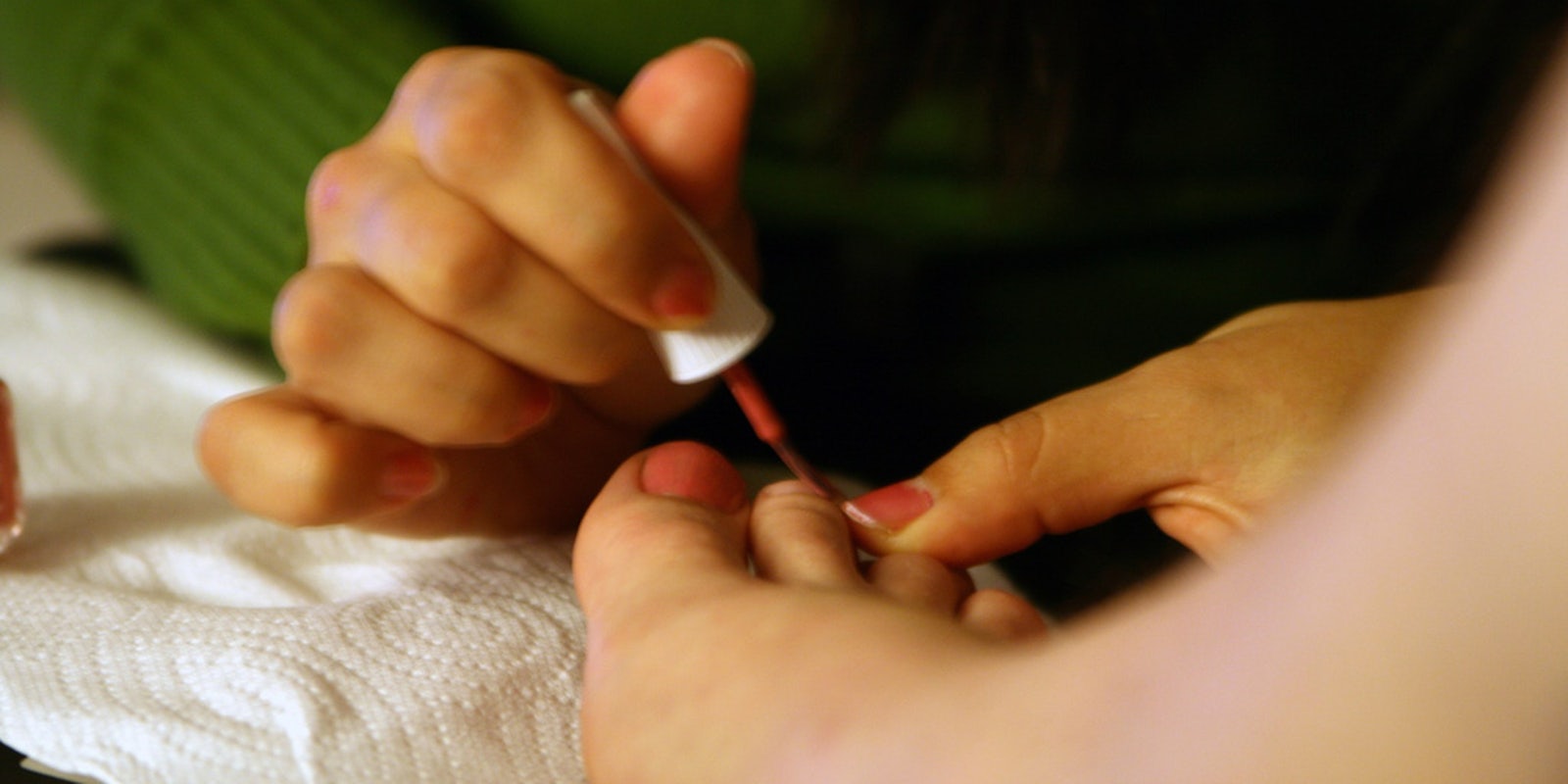In the latest exposé of the pink collar labor sector, where low-income service jobs employ mostly women, a New York Times investigation has found conditions resembling indentured servitude exist in many nail salons.
The first part of an investigative series, “Unvarnished,” was released today. The series examines the labor economics of New York-area nail salons, and the next installment is expected to delve into the health and safety conditions of these businesses.
In today’s story, “The Price of Nice Nails,” reporter Sarah Maslin Nir revealed how a complex racial hierarchy of Korean, Chinese, Hispanic, and other Asian employees operated in pyramid scheme-like work conditions. Female manicurists pay to be trucked in to salons from the suburbs, where they train for weeks without pay and even pay employers for training. Then when they are bumped up to paid employee status, many are shocked to discover their wages average about $30 a day. The most experienced manicurists, who average $80 a day for a 60-plus hour work week, still don’t rise above the poverty line.
Discussion of the deplorable conditions in New York nail salons isn’t new. Last September, Public Advocate Letitia James published a policy report citing grave safety concerns at the city’s nail salons, mostly in ways that adversely affected the health of salon workers.
“Toulene, formeldahyde, and dibutyl phthalate—commonly referred to as the ‘toxic trio’—are found in nail products and have been linked with reproductive harm, respiratory problems and cancer,” read the report. “And yet, out of the 10,000 chemicals contained in nail products, 89 percent have not been tested by an independent agency for safety. Due to increased exposure, workers are most at risk.”
A Korean community nonprofit surveyed 100 nail salon workers in partnership with James’ office for the report. They found that 37 percent of the workers had skin problems and eye irritation, 57 percent suffered from allergies, 66 percent battled back and neck injuries and discomfort, and 18 percent had asthma.
The New York Times investigation even found that some nail salon workers were charged for drinking the water at their workplaces, a blatant labor code violation that could lead to health problems like dehydration as well.
Some nail salon workers were charged for drinking the water at their workplaces.
Earlier this month, James took the report to the legislature and rallied for a Nail Salon Health and Safety Bill. The bill would require more inspectors to be trained to oversee the city’s 5,000 salons (currently, there are only 32 inspectors) and would require all salons to register with the health department.
It’s been an intense few years for the city’s nail salon workers struggling to fight for labor rights. A 2012 lawsuit awarded $250,000 to six Chinese workers at the Long Island chain of Babi Nails salons. The workers alleged that they had been routinely kicked and verbally abused by bosses while working and were paid below minimum wage. Those workers were organized by the Chinese Staff and Workers Association’s “Justice Will Be Served” campaign, which also sought to ensure worker’s rights for the guys who race around the city delivering food on bicycles and scooters.
The labor struggles taking place at the city’s notoriously cheap nail salons even inspired an art gallery/nail salon to open in 2012. The Hanns Eisler Nail Salon held events like “Misclassification Manicure Madness!,” where “precarious workers” could indulge in learning “2012’s most swoon-worthy nail trends and your best recourse against employment violations.”
But manicurists are just one segment of a labor sector that’s been called the Pink Ghetto, where women toil as domestic workers, nannies, sex workers, waitresses, elementary and day care teachers, nurses aides, sweatshop sewers, models, and more. These so-called “pink collar jobs” are classified by the overwhelming majority of female workers in the sector, low wages, lack of benefits and job security, and oftentimes, a service aspect to the work.
Today, the plight of the manicurists is trending on social media as horrified readers learn the true cost of their $10 manicures.
#ThePriceofNiceNails Makes me glad that I quit getting my nails done years ago. I think the last time I got them done was for my 21st B-Day.
— Shield Girl Forever (@AmbroseBeliever) May 7, 2015
https://twitter.com/WendyBrandes/status/596342354593894400
There’s always some hidden secret and thank goodness the #newyorktimes open up a can of worms with this story #ThePriceofNiceNails
— Ms Beltre (@rosemaryPSYD) May 7, 2015
New York Times reporter Jodi Kantor tweeted that readers were panicking about which nail salons were OK to patronize, in light of the expose.
NY Times readers are calling for a list of nail salons with ethical labor practices. #thepriceofnicenails
— Jodi Kantor (@jodikantor) May 7, 2015
Kantor also noted that the newspaper had translated Nir’s article into the three languages most frequently spoken by New York’s nail salon workers, to make the article accessible to the people who most need to read it.
Nice touch on @SarahMaslinNir‘s harrowing nail salon expose: Korean/Mandarin/Spanish versions so workers can read. http://t.co/leMF2KMI63
— Jodi Kantor (@jodikantor) May 7, 2015
Photo via Quinn Dombrowski/Flickr (CC BY 2.0)


